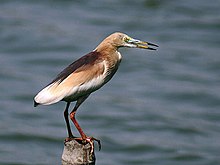Indian pond heron
| Indian pond heron | |
|---|---|
 |
|
| In non-breeding plumage | |
 |
|
| Breeding plumage in (Kolkata, India) | |
| Scientific classification | |
| Kingdom: | Animalia |
| Phylum: | Chordata |
| Class: | Aves |
| Order: | Pelecaniformes |
| Family: | Ardeidae |
| Genus: | Ardeola |
| Species: | A. grayii |
| Binomial name | |
|
Ardeola grayii (Sykes, 1832) |
|
 |
|
| Synonyms | |
|
Ardeola leucoptera |
|
Ardeola leucoptera
The Indian pond heron or paddybird (Ardeola grayii) is a small heron. It is of Old World origins, breeding in southern Iran and east to Pakistan, India, Burma, Bangladesh and Sri Lanka. They are widespread and common but can be easily missed when they stalk prey at the edge of small water-bodies or even when they roost close to human habitations. They are however distinctive when they take off with bright white wings flashing in contrast to the cryptic streaked olive and brown colours of the body. Their camouflage is so excellent that they can be approached closely before they take to flight, a behaviour which has resulted in folk names and beliefs that the birds are short-sighted or blind.
They appear stocky with a short neck, short thick bill and buff-brown back. In summer, adults have long neck feathers. Its appearance is transformed from their dull colours when they take to flight, when the white of the wings makes them very prominent. It is very similar to the squacco heron, Ardeola ralloides, but is darker-backed. To the east of its range, it is replaced by the Chinese pond heron, Ardeola bacchus.
During the breeding season, there are records of individuals with red legs. The numbers do not suggest that this is a normal change for adults during the breeding season and some have suggested the possibility of it being genetic variants.
plumage has been noted. The race phillipsi has been suggested for the populations found in the Maldives, however this is not always recognized. It forms a superspecies with the closely related Chinese pond heron, Javan pond heron and the Madagascar pond heron.
They are usually silent but may give a harsh croak when flushed or near their nests.
This bird was first described by Colonel W. H. Sykes in 1832 and given its scientific name in honour of John Edward Gray. Karyology studies indicate that pond herons have 68 chromosomes (2N).
...
Wikipedia

